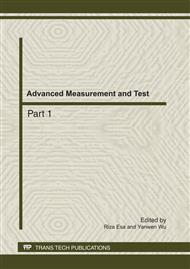[1]
J.B. Majer, F.G. Paauw, A.C.J. terHaar, C.J.P.M. Harmans, J.E. Mooij, Phys. Rev. Lett. 94 (2005) 090501.
Google Scholar
[2]
Y. Yu, S. Han, X. Chu, S. -I. Chu, Z. Wang, Science 296 (2002) 889.
Google Scholar
[3]
I. Chiorescu, Y. Nakamura, C.J.P. M. Harmans, J.E. Mooij, Science 299 (2003) 1869.
Google Scholar
[4]
S. Han, R. Rouse, J.E. Lukens, Phys. Rev. Lett. 76 (1996) 3404.
Google Scholar
[5]
J.R. Friedman, V. Patel, W. Chen, S.K. Tolpygo, J.E. Lukens, Nature 406 (2000) 43.
Google Scholar
[6]
C.P. Yang, S. Han, e-print quant-ph/0511206.
Google Scholar
[7]
J. Zhang, W. Liu, Z. Deng, Z. Lu, G.L. Long, J. Opt. B: Quantum Semiclass. Opt. 7 (2005) 22.
Google Scholar
[8]
A. Blais, R.S. Huang, A. Wallraff, S.M. Girvin, R.J. Schoelkopf, Phys. Rev. A 69 (2004) 062320.
Google Scholar
[9]
C.P. Yang, S. -I. Chu, S. Han, Phys. Rev. Lett. 92 (2004) 117902.
Google Scholar
[10]
L.I. Childress, A.S. Sorensen, M.D. Lukin, e-print quant-ph/0309106.
Google Scholar
[11]
A. Wallraff, D.I. Schuster, A. Blais, L. Frunzio, R.S. Huang, J. Majer, S. Kumar, S.M. Girvin, R.J. Schoelkopf, Nature (London) 431 (2004) 162.
DOI: 10.1038/nature02851
Google Scholar
[12]
T. Yoshie, A. Scherer, J. Hendrickson, G. Khitrova, H.M. Gibbs, G. Rupper, C. Ell, O.B. Shchekin, D.G. Deppe, Nature (London) 432 (2004) 200.
DOI: 10.1038/nature03119
Google Scholar
[13]
J.P. Reithmaier, G. Sk, A. Lffer, C. Hofmann, S. Kuhn, S. Reitzenstein, L.V. Keldysh, V.D. Kulakovskii, T.L. Reinecke, A. Forchel, Nature (London) 432 (2004) 197.
DOI: 10.1038/nature02969
Google Scholar
[14]
A. Badolato, K. Hennessy, M. Atatre, J. Dreiser, E. Hu, P.M. Petroff, A. Imamoglu, Science 308 (2005) 1158.
Google Scholar
[15]
C.P. Yang, S. Han, Phys. Rev. A 72 (2005) 032311.
Google Scholar
[16]
A. Joshi, M. Xiao, Phys. Rev. A 74 (2006) 052318.
Google Scholar
[17]
C.P. Yang, S.I. Chu, S. Han, Phys. Rev. Lett. 92 (2004) 117902.
Google Scholar
[18]
S.L. Zhu, Z.D. Wang, P. Zanardi, e-print quant-ph/0403004.
Google Scholar
[19]
L.M. Narducci, W.E. Eidson, P. Furcinitti, D.C. Eteson, Phys. Rev. A 16 (1977) 1665.
DOI: 10.1103/physreva.16.1665
Google Scholar
[20]
A. Biswas, G.S. Agarwal, Phys. Rev. A 69 (2004) 062306.
Google Scholar


